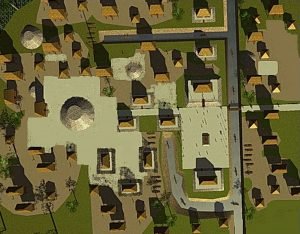Guacata – An inland Calusa village on Lake “Mayaimi” or Okechobee, south Florida, about 1570. Elsewhere in his memoir Fontaneda refers to it as a distinct but subordinate tribe. 1
Guacata, Cuacata – In one place Fontaneda speaks of this as a town on Lake Mayaimi (Okeechobee) and elsewhere as one of the provinces of the east coast. A Spanish document in the Lowery collection gives it as a place “in the land of Ays.” It is possible that these people lived on St. Lucie River and camped farther inland than most of the coast people. In that case they would probably be identical with the people of the town afterwards known as Santa Lucia from a missionary establishment started among them. 2

Guacata – Meaning unknown. On the evidence furnished by place names, the tribe is classified with the south Florida peoples. They were located on or near Saint Lucie River in Saint Lucie and Palm Beach Counties, Florida. The Guacata are first mentioned by Fontaneda (1854), who in one place speaks of them as on Lake Mayaimi (Okeechobee), but this probably means only that they ranged across to the lake from the eastern seacoast. Shortly after his conquest of Florida Menendez left 200 men in the Ais country, but the Indians of that tribe soon rose against them and they moved to the neighborhood of the Guacata, where they were so well treated that they called the place Santa Lucia. Next year, however, these Indians rose against them and although they were at first defeated the Spaniards were so hard pressed that they abandoned the place in 1568. They were still an independent body in the time of Dickenson, in 1699, but not long afterward they evidently united with other east coast bands, and they were probably part of those who emigrated to Cuba in 1763. No separate estimate of population has ever been made. In relatively late times many of these Indians were driven from their country into Florida. 3
In discussing the Belle Glade site in his manuscript, Randolph J. Widmer infers that the Belle Glade site is actually the site of Guacata. 4
Not only does the Belle Glade influence spread west into the Caloosahatchee area, it also spreads east toward the Atlantic coast and down the coast to near Fort Lauderdale, replacing the Circum-Glades ceramic types 5 , following Swanton’s 6 description of the location of this “tribe.” “Guacata,” however, refers specifically to a town on the eastern edge of Lake Okeechobe 7 . Further, Fontaneda 8 speaks of the cacique of Guacata, and the name may thus refer to a tribal group as well. What is known however, is that the cacique of Guacata, be it a town or an ethnic division, was on similar political standing with the caciques of the Ais, Jeaga, and Tekesta. The relationship of the other towns on the lake to Guacata is not known, but they were probably independent. This supposition is supported in part by Fontaneda’s statement that “they are masters of a large district of country, as far as a town they call Guacata, on the Lake of Mayami” 9 .
It would seem then, that the Belle Glade site, at least during its latest protohistoric phase, is actually the town of Guacata. This interpretation is based on the recovery of elaborate European grave goods from the burial mound at that site, including gold, silver, and copper items and glass beads 10 . We know that Carlos himself divided up the gold and silver plundered from a Spanish shipwreck among the chiefs of the Ais, Jeaga, Guacata, Tekesta, and other groups to the north 11 . The gold and silver found in the Belle Glade burial mound may actually be the spoils of this division.
Alternate Spellings
- Cuacata – Swanton, Early History of the Creek Indians, 333, 1922.
- Cuacata – Colección de documentos inéditos, 540, 1866.
- Guacata – Fontaneda, Memoir (ca. 1575), Smith translation, 19, 1854.
- Guasata – Fontaneda in French, Historical Collections of Louisiana, 2d., s., II, 245, 1875.
- Santa Lucia – Swanton, Early History of the Creek Indians, 333, 1922.
- Wakate – Thornton, Richard. The Native American History of Florida’s Lake Okeechobee Basin, 2014.
Citations:
- Hodge, Handbook of American Indians, 508, 1907.[↩]
- Swanton, Early History of the Creek Indians, 333, 1922.[↩]
- Swanton, The Indian Tribes of North America, 1953.[↩]
- Widmer, Randolph J. The Evolution of Calusa: A Nonagricultural Chiefdom of the Southwest Florida Coast, pp. 97-98. University of Alabama Press, 1988. Amazon.[↩]
- Griffin et al. 1979:33[↩]
- Swanton, The Indian Tribes of North America, 1953:131[↩]
- Fontaneda 1944:13[↩]
- Fontaneda, Memoir (ca. 1575), Smith translation, 20, 1854.[↩]
- Fontaneda, Memoir (ca. 1575), Smith translation, 13, 1854.[↩]
- Willey 1949a:60-61[↩]
- Fontaneda, Memoir (ca. 1575), Smith translation, 1854.[↩]
